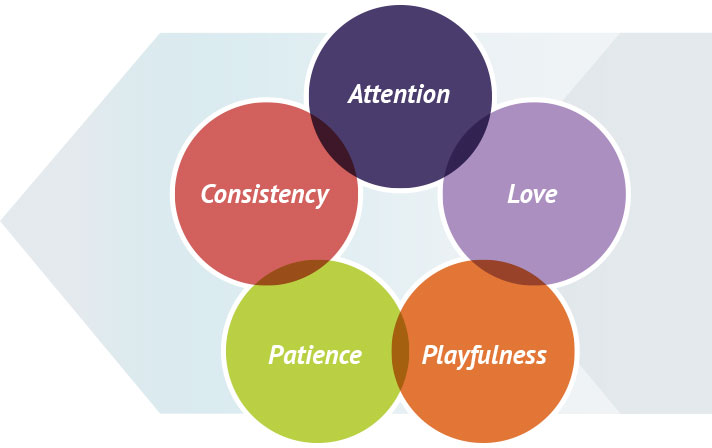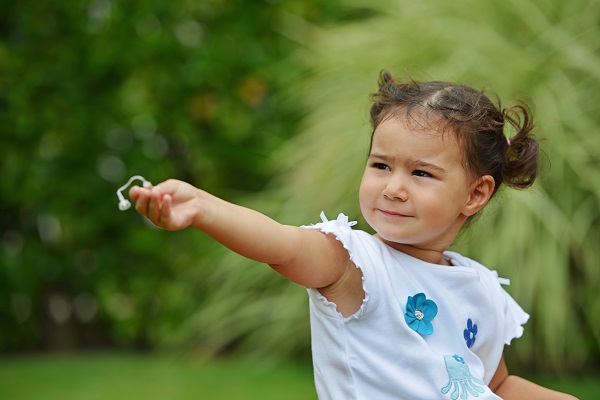Infants have basic but very important needs. When we respond to these needs, babies develop a sense of
security and trust. This becomes an essential foundation for later learning, loving and growing.

Attention
When your baby fusses, what do you do naturally? You pick him up and soothe him. This everyday routine helps your baby learn that he can count on you to respond to his needs.
Love
You may hear people say that you should not hold a baby too much, or you will spoil him. In the first six months of life, it is impossible to spoil a baby.
- At these young ages, babies fuss for legitimate reasons, including unspent energy, hunger, or teething.
- Our job as parents is to respond to these needs by holding, cuddling, feeding or soothing.
- These close moments convey a BIG message: I love you and I am here for you.
- When you give lots of cuddles and hugs, you meet your baby's emotional needs.
Playfulness
Parents of young infants are busy people.
Patience and Consistency
By nature, babies cry a lot. Cries are a baby's first way of communicating and getting his needs met.
- You may have already noticed that your baby cries in different ways to communicate different needs.
- A whimper might mean, "I'm not comfortable in this position."
- A strong cry might mean, "I'm really hungry and want to eat now!" Patience and consistent responses to cries are essential in the first six months.
- Consistency helps your baby learn to expect and trust that you will respond.
Positive Attention Remains Very Important When Babies Are Learning to Walk
Babies are naturally curious. They reach for and touch all sorts of things. But as babies begin to move, we often wish that they would stop doing some things. Of course, growing up is really about learning what we should do.
- Use gentle ways to remove your baby from dangerous situations.
- Anne Krueger states in
Parenting: A Guide to Your Baby's First Years (1999) Ballentine Books: New York, "Most of baby's so-called bad behavior isn't fueled by a desire to annoy you. Babies get into trouble because it's their job to explore every cranny, to poke every button, to grab every interesting thing they see."
Give Positive Attention
Babies need attention, and you have control over the kind of attention that you give. You will give different kinds of positive attention as your baby's age changes.
- Babies:
- Positive attention is more than just smiling when your baby pleases you.
- Babies need positive attention when they experience feelings.
- Although you would like to help your baby avoid certain feelings, learning and developing involve frustration and disappointment as well as excitement and pleasure.
- By naming your baby's feelings you will be preparing him to find positive ways to express those feelings later on.
- Toddlers:
- Toddlers love to have parents' attention.
- You can plan ahead to have special times together, playing or reading or pretending.
- This positive attention can include lots of natural language stimulation.
- Remember to follow your toddlers' lead and talk about what interests him.
- In a busy day, we don't always have time to give our undivided attention, and little ones may find inappropriate ways to try to get it.
- With some children, it can be effective to ignore certain behaviors, but others may need to be encouraged to explore a different activity.
- It is good to consider why he is trying to get your attention.
- Have you been very busy?
- Do you need to show him another way to get your attention?
- Can you spend more quiet time with him?
Let's Practice the Idea Of Giving Positive Attention with Examples
Situation: Your baby is playing peacefully on his blanket, repeatedly hitting his mobile. As it sways, it brushes his nose and scares him. He begins to cry.
a) Move the mobile out of the way. | "No, no." |
b) Pick up the baby and offer reassurance. | "That scared you. Mommy is here. It's okay." |
c) Wait for the baby to calm. | "It's okay sweetie."
|
d) After he settles down, play together with the toy and show him it will not hurt. | "You like your toy. See, it is fine. Let's play." |
Did you pick B and D? These responses give positive attention. They express what the baby is feeling and help him calm himself down.
Situation: Your hard of hearing baby is fussing and tugging at her hearing aid. She pulls it out and tries to put it in her mouth.

a) Take the hearing aids off and put them away for the rest of the day. | "No, no." |
b) Grab the hearing aid from her and put it right back in. | "No eating. You need to wear this." |
c) Gently take the hearing aid and hug and calm her. | “You took it out. Mommy has it.” (Put the hearing aid back in her ear once she is calm).
|
d) Give her something fun to mouth and explore and then slip the aid back in. | "Here's your rattle. Oh, you like to taste it." |
Did you pick C and D? We want the baby to wear the hearing aid as much as possible so putting it away for the day is not the best option. We also want to respond in a gentle and matter-of-fact way when putting it back in. We can give positive and loving attention to calm her, then give her something to do while we put the aid back in.
Situation: Your deaf baby is fussy in her infant seat and seems ready for a nap but will not settle down. She is fussy but doesn't want the bottle.
a) Pick her up, smile and sign to her. Touch her to soothe and quiet her. | "You want mommy? Mommy loves you. You are sleepy." |
b) Show her favorite toys and try to stop her fussing. | "Here, let's play a new game." |
c) Ignore her because she may just drift off to sleep. | |
d) Rock her and sign simple ideas. | "I love you. Bed time? Sleepy girl." |
A and D are the best choices. They give positive attention through facial expression, signing and touch. Offering favorite toys may be overly stimulating if the baby is tired. Ignoring her misses an opportunity for closeness that will help your baby go to sleep.